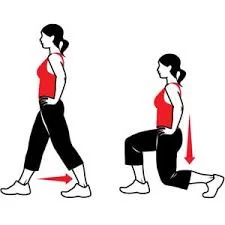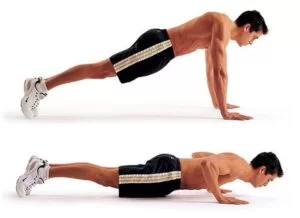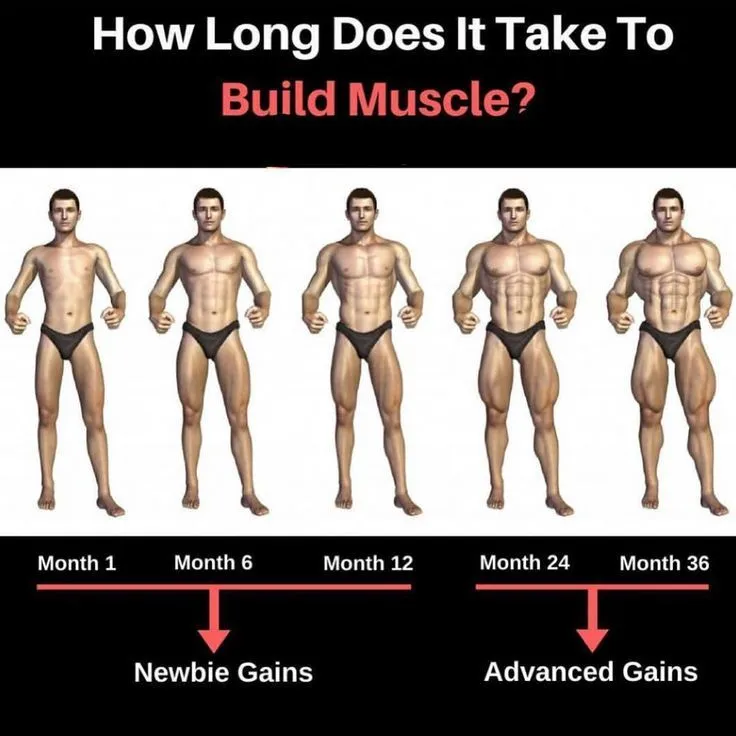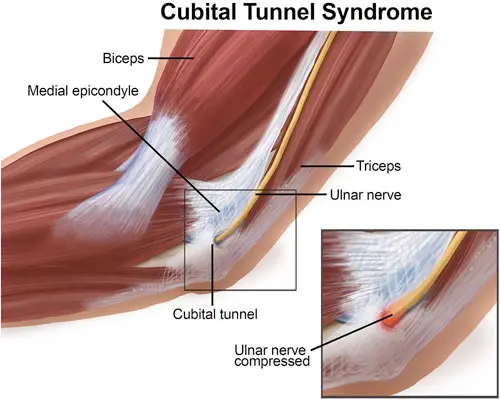How Long Does It Take to Build Muscles?
Building muscles is a gradual process that varies from person to person based on factors such as genetics, training intensity, nutrition, and recovery.
Typically, noticeable changes can be observed within a few weeks to a few months of consistent resistance training. However, significant muscle development often takes several months to years.
Introduction
Building muscle is much more prolonged than people think. It is an extremely slow and tedious process that can feel frustrating when you don’t see the muscle definition as early as you want it.
But if you are on a search for bigger and more toned muscles, it is essential to start your new workout plan with the proper expectations. Raising weights is the most useful way to build muscle over time. The analysis supports resistance training, especially weightlifting, as the best approach for creating hypertrophy (the scientific term for muscle growth).
Here you will know how long it takes to build muscle and what factors affect your ability to get stronger, slimmer, and fitter from weight training.
Strength training, in addition to a routine exercise program that includes cardio and eating nutritious meals containing protein, can help build up your muscles.
You have probably heard that you should be incorporating strength training into your workout routine. Still, hitting the weights may feel much more harsh than taking a walk or jogging around your neighborhood.
While effects may not consistently be fast, making a solid strength training exercise should show you prominent muscle gains in a few weeks to several months.
When you begin weightlifting training, you like results fast. Most people do not pick up weights and put them down for fun. It depends on different factors, such as age, diet, how much and how frequently you lift, and more.
Here’s our advice to safely and effectively gaining muscle.
Building muscle is not very hard. If it was comfortable, it would be easy. There is no perfect muscle-building timeline because many factors affect your ability to build muscle mass, including:
Your protein intake: Although each macronutrient plays a specific role in muscle growth, the protein role is main After the strain of weight exercise, your muscles need enough protein to heal. Muscle growth stops when insufficient protein is consumed.
Your calorie intake: Even if you consume a lot of protein, you won’t gain muscle if you do not consume enough calories each day. Your body has to produce new tissue to gain muscle; it cannot make anything out of nothing. Muscle growth and recuperation are accelerated by excess fuel from extra calories. Because they are unwilling to deal with the excess body fat that comes along with a muscle-building period, this is one of the reasons why many people never achieve their goals of increasing their muscle mass.
Your sleep schedule: Sleep fatigue is not a good combination for lifting weights. Giving your body an equal chance at healing will not only prevent you from seeing some gains, but it will also prevent you from optimizing muscle growth.
Your lifting routine: Two essential strength training principles are volume and frequency, which are important to understand if you’re attempting to gain muscle. Volume is the overall load that is applied to a muscle during training, whereas frequency is the frequency at which a muscle or muscle group is trained.
For instance, your total volume will be 3,000 pounds if you execute three sets of 10 reps with 100 pounds for squats. Unless you overtrain, more volume and higher frequency usually translate into more muscle.
Your training age: You will observe less muscular gain the more advanced you are (yes, that seems backward). Everybody has a maximum genetic potential for muscle growth, and the harder it is to gain more muscle, the closer you come to your genetic potential.
Your actual age: As with many things, gaining muscle becomes more difficult with age. Loss of muscle mass and function, or sarcopenia, is a major issue among the elderly. That’s one of the main reasons it’s critical to maintain an active lifestyle as you age.
Additional significant determinants include your testosterone levels, which explain why males usually have more muscle than women, and your genetic potential for muscle growth, which is hard to measure without scientific testing and even vague. Muscle growth is also influenced by other hormones, such as insulin growth factor and human growth hormone.
However, when you put your muscles to the test, the process of growing muscle begins. Within six weeks of beginning a resistance training program, true novices may notice muscular growth, and after a six to eight-week break from their regular strength training routine, advanced lifters may observe improvements.
Even with the ideal nutrition, sleep schedule, and exercise routine, muscle growth is a process that takes several weeks to see results, regardless of fitness level.
How to Gain Muscle Mass?
Lifting weights causes stress to the muscles, which is often referred to as a muscle injury. This kind of exercise activates satellite cells outside the muscle fibers, which then unite to heal the damage. Your muscles grow because the joint cells produce more muscle fiber.
By regulating muscle mass, generating new blood capillaries, and regulating satellite cells, certain hormones can promote muscular growth. Your body releases growth hormones from your pituitary gland whenever you work out with resistance. Hormone release increases with the intensity of your workout. The growth hormones will cause you to
The most flexible type of tissue in your body is skeletal muscle. Muscle injury is the result of traumatizing your muscle fibers during intense exercises, such as weightlifting. This type of injury to your muscles activates satellite cells, which are located outside the muscle fibers. They come together in an attempt to repair the damage, which increases muscle fiber.
Certain hormones also aid in the growth of your muscles. They are in charge of the satellite cells and are in charge of the following:
- transmitting the cells to your muscles after exercise
- creating new blood capillaries
- repairing muscle cells
- working muscle mass
Resistance training, for instance, facilitates the release of growth hormone from the pituitary gland. The amount released is a function of the exercise’s intensity. To build muscle, growth hormone accelerates your metabolism and aids in the conversion of amino acids into protein.
How to build muscle?
It’s not necessary to spend your entire day in the gym to gain muscle. To see results, two to three times a week for 20 to 30 minutes of weight exercise is sufficient. During your weekly workouts, you should aim to train on all of your major muscle groups at least twice.
Strength training can assist in encouraging muscular growth even with just one session, even if you might not notice effects immediately. Exercise in the two to four hours following a workout is known to boost what’s called protein synthesis. Your levels can remain high for an entire day.
In what precise way can you detect the growth of your muscles? There might be a more distinct muscle definition seen. If not, eventually you’ll be able to lift bigger weights with greater ease.
Strength training activities include:
- Bodyweight workouts, like pushups, squats, and lunges
- Resistance band exercises
- Workouts using free weights or even random items like soup cans
- Exercises with stationary weight equipment, such as a leg curl machine
You should aim to complete eight to fifteen repetitions in sequence when lifting. just one set. Between sets, give yourself a minute to relax. Complete a second set of the same length after that. It should take you about 3 seconds to raise or lower your weight. After maintaining that posture for a full second, slowly drop the weight over three more seconds.
Resistance vs. reps
Lifting weight, sometimes referred to as resistance, that is heavy enough to push oneself should be your goal. Choosing a weight that causes your muscles to tire out after 12 to 15 repetitions, or reps, is an excellent starting point. Try progressively increasing the weight to the next level if you discover that lifting weights is too simple for you.
Compared to three sets at a lesser weight, even one set of 12 repetitions at a sufficiently high weight can aid in muscle growth. Find out more about the advantages of doing intense weightlifting.
Why rest is important?
Giving your body enough rest before starting a strength training program is important. If you don’t take days off, you run the risk of hurting yourself and having to stop working out, which could hamper your growth.
Strength training on the same muscle group twice in a row is not advised by experts.
Do women and men develop muscle mass at the same rate?
Women and men develop muscles in different ways. This is because testosterone is essential for the growth of muscles. Although testosterone is present in the bodies of both sexes, men have higher levels of this hormone. However, research from the year 2000 indicates that the way men and women react to strength training is similar.
Additionally influencing muscle growth is:
- Body size
- Body composition
- Hormones
People of both sexes who have higher baseline levels of muscle mass generally see more visible changes in muscle mass.
Cardio and muscles
Exercise that increases heart and breathing rates is called aerobic exercise, or cardio. Your heart system is strengthened by it.
You may have heard that lifting weights too much requires cardio. This isn’t always the case, according to recent studies.
In addition to improving your general exercise capacity, aerobic exercise can aid in muscle growth and function. Older and formerly sedentary people are more affected by these impacts.
The ideal range for cardiac exercise to support muscle growth is determined by its intensity, duration, and frequency. It is recommended by Scientists to engage in cardiovascular exercise four to five days a week at an intensity of 70 to 80 percent heart rate reserve (HRR) for 30-45 minute sessions. By deducting your maximal heart rate from your resting heart rate, you may determine your HRR.
In summary, maintaining a strong and healthy body and heart can be achieved by a combination of aerobic and weight training routines.
Diet and muscles
The meals you consume might also aid in your muscular growth. Specifically, the amount of protein you consume is crucial for providing your muscles with energy. How much protein ought to be consumed? For adults over 19, the current recommendation is approximately 0.8 grams (g) per kilogram (kg) of body weight per day.
A 150-pound lady, for example, would require about 54 grams of protein per day. (54.5 g) x 0.8 g = 68 kg. Conversely, a 180-pound male would require about 66 grams of protein each day. (65.6 g) x 0.8 g = 82 kg.
Not sure what to eat? Seek for foods that are high in leucine and high in protein. Leucine is present in animal products such as:
- Beef
- Lamb
- Pork
- Poultry
- Fish
- Eggs
- Milk
- Milk products, like cheese
Non-animal sources of protein include foods like:
- Soybeans
- Beans
- Nuts
- Seeds
Muscle Gain Over Days, Weeks, and Months
Your muscles will start to get injured as soon as you pick up weights. After one to seven days, depending on how hard you work out, your muscle cells can regenerate larger and more powerful. To maintain a regular schedule until they grow back, you should train on different muscle groups.
The body’s neurological system begins to learn when and how to fire the correct muscle cells in the first few weeks of a new weightlifting regimen. The majority of the strength gains you’ll experience throughout the first four to six weeks of your program are caused by these neurological alterations. Your strength gains will be mostly derived from actual muscle growth the longer and more frequently you train out.
While skilled lifters would notice changes in three to four weeks, most beginners will show considerable muscle growth within eight weeks. With the correct strength training and diet regimen, most people grow one to two pounds of lean muscle each month.
Best Ways to Work Muscles
See your doctor to ensure that the workouts are appropriate for your age and any underlying medical concerns before starting a new fitness program. You’ll usually see benefits if you lift weights for 20 to 30 minutes, twice or three times a week. Try working with a personal trainer who can create a plan specifically for you if you are unsure about what muscle groups to target or how to gain muscle.


Some common exercises include:

- Pushups
- Squats
- Lunges
- Resistance band movements
- Free weights
- Stationary weight machines
You should perform eight to fifteen repetitions in a sequence, or one set, each time you lift. After a minute of rest, perform a same-sized set again. When lifting, push or lift your weight into position for three seconds, then hold it there for one second. Over three more seconds, lower the weight to its initial position.
The following five methods will help you grow muscle more quickly:
- Train each muscle group twice per week.
- Consume one gram of protein for every ideal weight.
- complete 10-12 reps with 1 minute of rest.
- Consider the range of motion resistance training.
1. Train each muscle group twice per week. Aim to work out each major muscle group at least twice a week to optimize muscular growth. A 2016 Sports Medicine analysis found that splitting your workouts for your legs, back, or chest into two days will promote more muscle growth even if you don’t work that muscle any harder or longer. Though the benefits of training every muscle group three days a week over two are still up for debate, this approach is probably best suited for more seasoned lifters than novices.
Try dividing your weekly routine according to body parts or muscle groups so that you can work on a particular muscle group two or three times a week without working on the same muscle groups back-to-back days.
2. Consume one gram of protein for every ideal weight. Your muscles are made up of the protein you eat, which is essential for muscular development and repair. As a general guideline, Matheny advises musclebuilders to consume one gram of protein per kilogram of their target body weight each day, spaced out over the day.
According to a 2018 study published in the Journal of the International Society in Sports Nutrition, If the person is not on a diet, their “daily protein intake for the purpose of maximizing resistance workout-induced gains in muscle mass and strength” is approximately one gram of protein for every kilogram of body poundage.
3. After 60 seconds of rest, perform 6–12 repetitions. According to research, a good strategy is to perform 6–12 repetitions with a 60-second rest period in between. Additionally, Smith-Ryan points out that increasing the number of exercises performed for a given muscle area will result in greater training volume and growth improvements. According to Smith-Ryan, “Your training stimulus has the largest impact on your degree of muscle growth.” “It must be large enough with enough volume.” The term “training volume” refers to the product of the weight lifted and the number of repetitions and sets performed with that weight.
4. Consider the range of motion resistance training. A meta-analysis published in 2020 in SAGE Open Medicine suggests that when it comes to resistance training, you should perform movements with a full range of motion for your lower body muscles. The meta-analysis states that there is “less conclusive” data supporting the benefits of such exercise for the upper body.
5. Exercise frequently if you’re a beginner. Exercise more regularly if you’re new to the gym “because you are in part learning and improving general movement patterns and mobility,” according to Matheny.
Because they recover more slowly from injuries, younger people should be able to train more frequently than older ones. You get a 10% reduction in recovery time every ten years after the age of thirty.
Here are some more tips for beginners:
- Do an aerobic warm-up for five to ten minutes, such as brisk walking. You can prevent injuries from going out with chilly muscles by doing this.
- If necessary, start light and only use 1- or 2-pound weights. Since you’re still lifting your body weight with your arms and legs, you might even attempt performing strength training exercises without any weight.
- Gradually increase your weight. Injury is a sure thing when you lift too much too quickly. That being said, you won’t see improvements if you don’t push your muscles. After 12 to 15 repetitions, try lifting a weight that causes your muscles to tire.
- Lift the weights with deliberate movement. Refuse to swing an excessively heavy weight by causing uncontrollable motion at your joints. This could result in harm.
- Breathe normally when working out. Exhale while pushing or lifting a weight. Inhale as you relax.
- It’s normal to have some discomfort and mild muscle fatigue for a few days. Maybe you’re taking on too much if you’re feeling really tired and hurting. You should not be in pain after exercising, so stop for a while.
- Include cardio in your training program. Running is an example of an aerobic workout that, when done at the proper intensity, length, and regularity, can aid in muscle growth.
- Consume a balanced diet that includes enough protein. These foods contain amino acids like leucine, which will help you gain muscle during your workouts. Vegetable foods are enough, but animal sources have the greatest protein.
Never forget to see your doctor before beginning a new exercise regimen, particularly if you have a medical problem. They might provide suggestions for safe adaptations to your exercise routine.
How to tell if you’re building muscle
The most frustrating thing about changing the way you look is that you may not notice results right away or be sure that all of your hard work is worthwhile. Here are five strategies to monitor your progress and help you keep on top of your goals before you get too worked up over whether you are gaining too much weight or not at all.
- You’re gaining weight
One of the simplest methods to determine whether your efforts are paying off is to monitor changes in your body weight. Although the scale might not always rise daily, it should gradually and steadily rise week after week.
Due to variations in hormones, water weight, and nutritional modifications, you will normally experience significant fluctuations in weight, particularly in the early stages. However, most of these variations ought to level out after three or four weeks, at which point the scale ought to start moving in the proper direction.
To see your long-term improvement, weigh yourself at the same time every day and put the results on a chart.
- Your clothes fit differently
Clothes that fit you differently after getting jacked typically do so in a positive manner. Your body is likely acquiring healthy weight if you notice that your shirts are becoming a little tighter around the shoulders, chest, and biceps, or if your trousers are becoming tighter in the thigh and hip area.
- Your building strength
Increasing strength and muscle mass usually go hand in tandem. You should start to notice improvements in your fitness level as well if you’re giving your body the right nutrition and doing strength training several times a week.
Sensation of strength is one thing, but weekly exercise logs are the most effective way to monitor this. Keep track of the number of repetitions and the weight used, and try to add more each week. For this, training regimens that use progressive overloads are ideal.
- Your muscles are looking “swole”
It’s acceptable to feel larger or puffier; this is probably an indication that your muscle fibers are expanding. Particularly when you are first starting with strength training, lifting weights increases the amount of fluids that reach your muscles, giving you that post-weight training pump. Even while some of the water retention may go away with time, you should still feel heavier.
Daily or weekly progress shots are among the finest ways to gauge your visual development. Take a snapshot of your entire body while facing a mirror. Iterate and evaluate your transition frequently. The outcomes will astound and inspire you in equal measure.
- Your body composition has changed
Evaluating your body composition at the start and finish of your bulk is ultimately the most effective method to track your progress in terms of muscle gain. Alternatively, you can arrange a DXA/DEXA scan, which provides an estimate of your body fat percentage with a 1.6% margin of error, or use an inexpensive and practical at-home scale.
More than whatever body fat you may have gained, you should be witnessing an increase in your lean body mass. Consider slowing down your bulking and reevaluating your diet if you’re finding that you’re accumulating significantly more fat than you had anticipated.
FAQ
What is the duration required to develop apparent muscle?
It depends on the individual and their genetics, even though it does frequently take 6–10 weeks of rigorous strength training and a healthy diet to see substantial muscle gain. But you have power over a lot of things.
How can I tell whether my muscles are growing?
You will probably experience more softness if you gain weight, On the other hand, gaining muscle may cause your muscles to naturally appear more defined and noticeable. They might also feel “harder” or appear larger.
What promotes the growth of muscles?
After a workout, eating adequate calories and protein promotes muscle growth and recovery. Since protein makes up muscle, it’s critical to consume enough of it after strength training to prevent muscle protein breakdown and promote muscle synthesis, or the formation of new muscle.
Is 30 minutes of exercise a day sufficient to gain muscle?
The way to gain muscle. It’s not necessary to spend all day in the gym to gain muscle. To see results, two to three times a week for 20 to 30 minutes of weight exercise is sufficient. During your weekly workouts, you should aim to train on all of your major muscle groups at least twice.
Which muscle is easiest to develop?
Yes, the easiest muscle group to build is your legs. your legs constitute the greatest muscle group in your body. They’re also a part of some of the most complex exercises, such as lunges and squats, which engage your entire body, including your core and other muscle groups in addition to your legs.
Which muscle is most difficult to develop?
Many people give up trying to build their calf muscles because they are thought to be among the hardest to do in the gym.
References
- How Long Does it Take to Build Muscle? (n.d.). https://gwrymca.org/blog/how-long-does-it-take-build-muscle#:~:text=Most%20beginners%20will%20see%20noticeable,in%20three%20to%20four%20weeks.
- Castaneda, R., Fetters, K. A., & Otten, M. (2022, March 31). How long does it take to build muscle? US News & World Report. https://health.usnews.com/wellness/fitness/articles/how-long-does-it-take-to-build-muscle
- Marcin, A. (2023, March 22). What you should know about building muscle mass and tone. Healthline. https://www.healthline.com/health/how-long-does-it-take-to-build-muscle#takeaway







One Comment